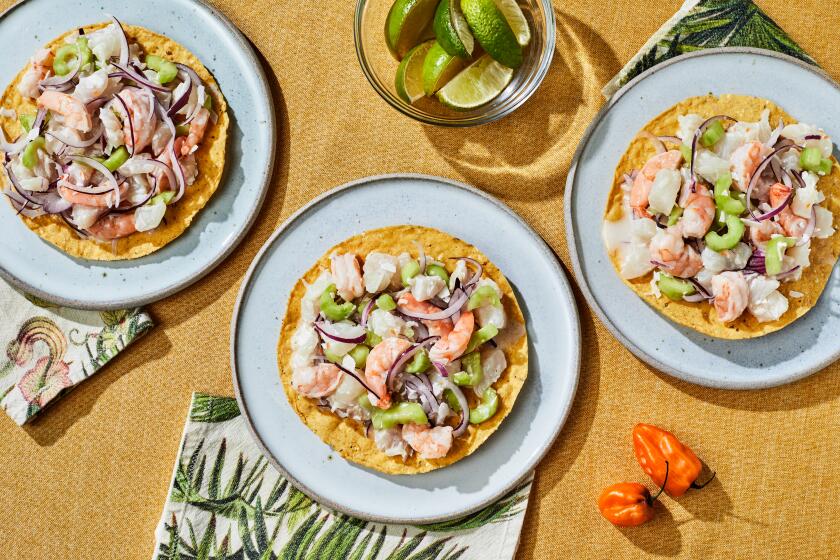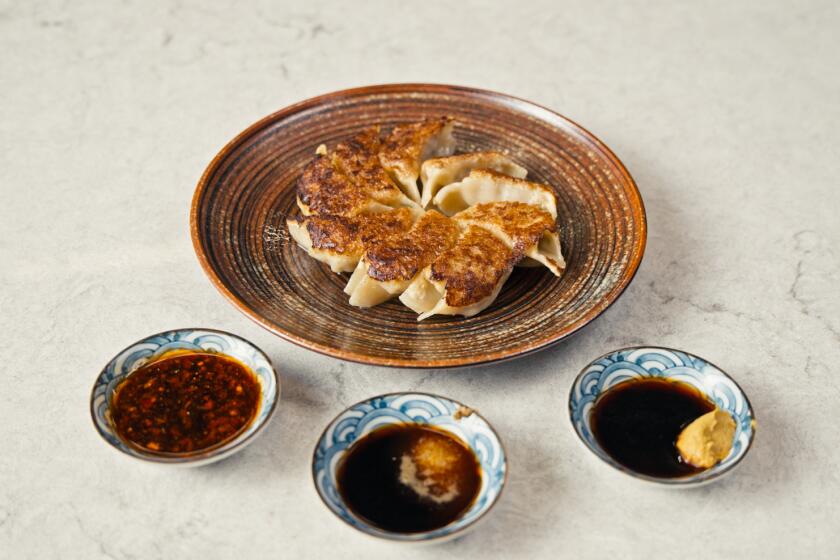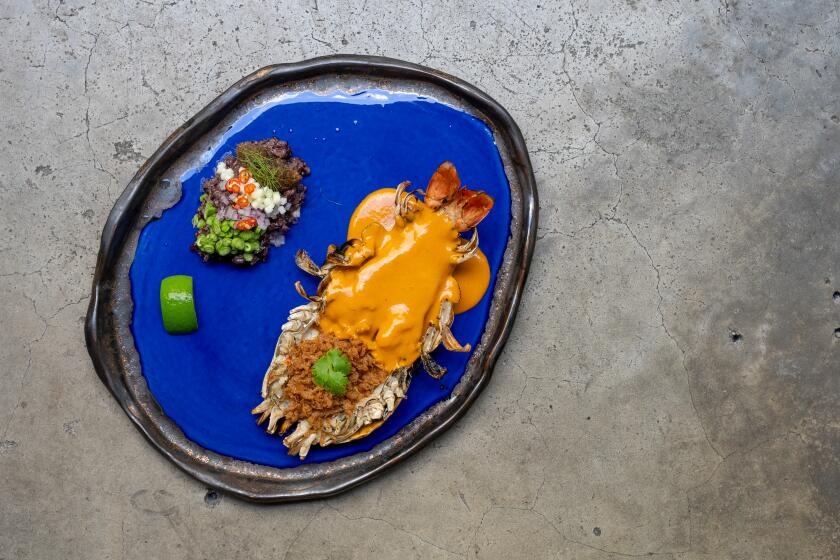Assorted fig appetizers

With the flame burning at the Olympic Stadium in Athens, you might want to light your own in the kitchen. In my experience, guests tend to become antsy and hungry during torch-related activities and archery. Just in time -- you’d almost think the publishing industry plans these things -- there are two new books on Greek food and cooking that will help.
The first is “The Olive and the Caper” by Susanna Hoffman (Workman Publishing, $19.95). Hoffman is an anthropologist whose sharp eye for human manners adds dimension to her food writing, which has a scientist’s precision and a humanist’s warmth. She describes, for instance, the custom of eating mezedes (the plural of meze) as “counterpoints taken with drink ... meant to mitigate the effects of alcohol, satisfy any stirring hunger, and hold the social verve in bounds.”
In classic Workman style (remember “The Silver Palate Cookbook”?), this is a big, chunky and energetic paperbound volume (589 pages, more than 300 recipes), decorated with fanciful graphics and lettering. Slick it’s not: The only color photos are in a 16-page insert in the front of the book.
The recipe margins are packed with ancillary information -- in this case, historical tidbits and stories of contemporary manners that help convey a sense of the great Greek food culture.
Here Hoffman brings a delightful personal touch. As a prelude to a delicious eggplant and yogurt spread, for instance, she provides the story of Miltiades, the 80-year-old father of one of her friends, who told her his tale on an Athens balcony as they were watching eggplant “wrinkle over hot coals as if aged by Kronos, the god of time, right before our eyes.” As a young man from Crete with a taste for the earthy and rough cuisine of his region, Miltiades fell in love with a delicate, high-born woman who had lost her wealth and home when her family was forced out of Turkey. To woo her and her refined palate, he searched out a more “haute” and smooth eggplant recipe and thus was able to “move into her heart and, more important, into her kitchen.” The story somehow enhances one’s enjoyment of the dish’s creamy texture.
Her recipes are simple, tasty and very Greek. She gives us marinated shrimp Cretan style (which simmer in wine, oil, garlic, parsley, oregano and lemon juice), made vibrant by a last-minute drizzle of salty lemon dip with capers.
She’s created a satisfying taramasalata with potato, which achieved the right level of mysterious sea taste even though I could find neither the carp roe nor the codfish roe she called for. I used the more ubiquitous whitefish roe instead and was not sorry.
Hoffman supplies a complete range of recipes, including one for field greens, fennel and ouzo pie; a traditional, roasted lamb shank with spices; and baklava. I felt compelled to try my hand at one of the Mediterranean’s best-known mezedes, stuffed grape leaves. Big surprise: Hoffman’s are much more interesting than the soggy ones you find at many Middle Eastern eateries all over town. Hers are stuffed with short-grain rice, pine nuts, currants and golden raisins.
Beef and rice meatballs known as youvarelakia are simmered in a wonderful yogurt-tomato sauce. Tender and tangy, this dish is delicious.
However, like many of the recipes I tested, it wants a little more salt than Hoffman specifies, and she often neglects to include an “adjust seasonings” instruction.
The tastes of the ancients
However similar in subject, “The Philosopher’s Kitchen” (Random House, $35) is strikingly different in tone and aesthetic. This book is elegant, pristine and beautifully photographed by Tim Turner. Author Francine Segan turns a neat trick: She takes cursory recipes from ancient Greece (and Rome) and makes them vibrant and cook-able.
As a writer she is less than inspiring -- her introduction, for instance, has all the excitement of the World Book encyclopedia. (“The ancients’ legacy includes the Mediterranean diet and many insights into medicine, health, and longevity from Hippocrates and others. It was Hippocrates who first noted the diagnostic value of interpreting a patient’s dreams, and still today all physicians take the Hippocratic oath.”)
But Segan’s recipes are excellent: simple, sophisticated and delicious, with enough latitude to give a creative cook room to maneuver. Each of the four I tried was a keeper.
Among my favorites: lamb on skewers with a piquant and rich mint marmalade (which works brilliantly for any cut of lamb, by the way); assorted fig appetizers (easy and impressive looking); and pork chops that are simmered first in a dry white wine, then finished with a dessert wine.
Segan sometimes supplies quotes from various BC luminaries as headnotes. She reminds us that it was Aristophanes, in his play “The Birds,” who first observed, “Women! Can’t live with them, or without them” and that women always ate after the men had finished (no wonder they were so hard to get along with).
Perhaps most interesting, Segan follows many of her creations with the ancient “original recipe,” usually written by men named Apicius or Athanaeus.
These tend, as most ancient recipes do, to be fascinating in their brevity. The original instructions for cooking what Segan has transformed into “salmon with berry glaze,” for instance, reads as follows: “A huge dog-fish is put in my hands; I baked the middle slices, but the rest of the stuff I boiled, after making a mulberry sauce.”
Segan’s recipes make you grateful for modern recipe standards. They also will guide you, during the archery event, to hit a bull’s-eye in the kitchen.
Bring the figs and wine to a simmer in a saucepan over low heat and cook until the figs are soft, about 5 minutes. Remove the figs with a slotted spoon. Continue cooking the wine until very thick and syrupy, about 10 minutes. Reserve.
Cut 1/4 inch off the tops of 6 figs and set the figs, cut side up, on a serving platter. Top each with one-half teaspoon of the cheese and sprinkle with the lemon zest.
Remove the stems from 6 more figs and halve the figs lengthwise. Pile the pistachios on a small plate and press the cut portion of each fig into them until the nuts adhere. Arrange the pistachio fig halves on the serving platter and drizzle with a little honey.
Remove the stems from the remaining figs and halve the figs crosswise. Make a small cavity in each center with the tip of your finger. Cut the prosciutto into one-half-inch-wide strips; roll each into a bundle and press into each fig. Place the stuffed figs on the serving platter and drizzle with the wine syrup.
Get our Cooking newsletter.
Your roundup of inspiring recipes and kitchen tricks.
You may occasionally receive promotional content from the Los Angeles Times.















